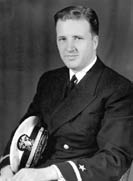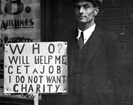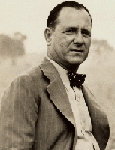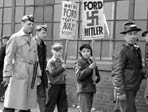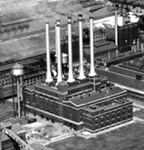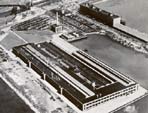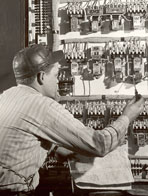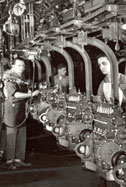
“An Economic ‘Frankenstein’”: UAW Workers’ Response to Automation at the Ford Brook Park Plant in the 1950s
Ford Embraces Automation at Brook Park
Automated manufacturing reached back to Milwaukee’s A. O. Smith automobile frame plant and the British Morris Motors engine plant in the 1920s and gained momentum in the manufacture of military materials during World War II. Meanwhile the emergence of the UAW’s assertive industrial unionism during the Great Depression challenged managerial prerogatives and forced reformulation of wage calculations in the immediate post-World War II years. Automobile workers now demanded a larger and larger voice in how the shop floor was managed and how the economic pie was divided. As the cost of unionized labor increased, so too did the potential savings automobile companies could realize through automation.
At the same time, Ford had a heritage of troubled labor relations from the brutal Harry Bennett era. Though the UAW acquired full recognition in the violent 1941 Ford strike, the River Rouge plant experienced several hundred strikes during World War II despite the UAW’s no-strike pledge, as well as turbulent shop-floor relations between supervisors and workers. River Rouge’s Local 600 also had leftist leadership and a militant membership. Although Henry Ford II managed to wrest control of labor relations from Bennett in 1946 and hoped to establish a softer human-relations program, Ford officials, in the words of Robert Asher, “constantly tested the power of its [River Rouge’s] production workers and the authority of the UAW.” This testing of union shop-floor power involved numerous workplace disputes over production standards. In the late 1940s Ford officials insisted on their unilateral right to set new production standards. In 1949 the sixty-two thousand River Rouge workers, who then constituted 58 percent of the Ford workforce, exploded with a twenty-five-day strike against management’s speed-up efforts. “In 1948 and 1949,” Asher observed, “Ford tried to force the UAW to accept a virtual ‘unconditional surrender’ of the rights of workers to bargain with management on production standards. It was a major offensive. The UAW counterattacked. Ford lost the battle.”
The River Rouge local’s militancy certainly influenced Ford’s decisions to decentralize operations away from Detroit and undertake an expensive automation program. The River Rouge workers were so aggressive and intractable that the prospect of an almost workerless factory teased and tantalized Ford officials. They had already embarked on an automation program prior to the speed-up strike, and it surely influenced their decision to move forward with an automated stamping plant in Buffalo and later the Brook Park engine plants and foundry. Constructed between 1951 and 1955, the Brook Park facility consisted of three separate buildings—engine plant no. 1, the foundry, and engine plant no. 2. Originally, Ford production engineers designed each plant to employ about three thousand workers, although the plants did not approach full capacity until around 1956. The new complex constituted an integrated production system for the eventual manufacture of Ford, and later Mercury, engines. The facilities, Ford officials reported, would “constitute a highly integrated production operation, with complete interdependence in both scheduling and production.”
Until the Cleveland plant was constructed, workers were essential to productive operations in the automotive machine shops. Even in the most modern plants, workers were required to move the castings from machine to machine. Since operators continued to handle the work, they also managed to control and pace production. “Despite metalworking’s progress in building and using the high-speed machine and the transfer machine,” wrote Rupert Le Grand, associate editor of American Machinist, “operators still generally handle loading, cycle starting, and unloading. The operator paces output.” In the Brook Park plant, Le Grand continued, Ford engineers overcame “the failure to realize the true potential of modern machine tools and metal-removal rates.” In other words, modern machine tools could cut metal faster than workers could load and unload the machines. Consequently, the use of automated methods offered “important gains . . . in respect to the number of pieces that can be produced hourly and in savings of direct labor.” Ford Vice President D. J. Davis claimed that automation achieved 80 percent efficiency, whereas without automation “you would be lucky to get 65 percent efficiency in that line.”
The mechanization of materials handling was the secret of Ford’s success in automation. The Ford automated production line used conveyors and “automation devices” for materials handling. “In the postwar boom,” Le Grand reported, “Ford had to conserve jobs where human skill is needed, and it had to get more pieces through existing machines in a shift.” One way was to substitute mechanical loaders for human production workers. These mechanical loaders, or automation devices, eliminated worker intervention as castings moved between machines on the huge transfer lines. Essentially, an operator loaded rough stock onto the transfer line’s first automation device and the piece moved from machine to automation device to machine until another operator removed the completely machined casting at the end of the line. “Perhaps for the first time . . . ,” Joseph Geschelin claimed, “the progressive transport of all parts and subassemblies has been automated, into and out of machine lines and onto monorail conveyors.”
The heart of the Ford automated production system was the cylinder-block machining line. According to Ford officials, this was “a veritable assembly line” that moved the work sequentially from operation to operation and which, “if stretched out in a single line, would extend for some 1200 to 1500 feet.” This battery of machines performed more than five hundred operations, one labor researcher reported, “without any human assistance.” Ford officials stated that one segment of the machine performing broaching operations was 100 to 120 feet long and processed forty to fifty pieces at one time: “All of these various operations are interlocked with electrical connections so that if there is any failure in any of these complex mechanisms, production will stop and will remain stopped until the defect is corrected.” In effect the cylinder-block machining line was a single massive machine composed of a thoroughly integrated complex of smaller metal-working and transfer machines.
The Cleveland engine plant greatly reduced production costs. For the most part, the savings came from the displacement of semiskilled machine operators and the increased speed of operations. Before the installation of the new machines, according to Bernard Karsh, it took four hundred workers forty minutes to machine an engine block; automated production required forty-eight workers and fewer than twenty minutes. Other accounts described similar reductions in the number of workers and the amount of time needed to machine a piece.
Among themselves, automobile manufacturers were quite frank about the use of new technologies to displace workers. “Automation,” one Big Three manager told E. J. Tangerman, the executive editor of American Machinist, “is any operation that removes a man from production.” Upon reflection, however, this executive added, “Don’t pin my name on that. We have a labor problem to think of.”
<<Previous Section - Next Section>>
Automation’s Effect on the Brook Park Workforce
Ford Embraces Automation at Brook Park
Negotiating Job Classifications and Pay Rates at Brook Park
Worker Absenteeism and Grievances
About the Project | Credits | Contact Us | Student & Teacher Resources | Site Map
©2004-2010 Automobile in American Life and Society
